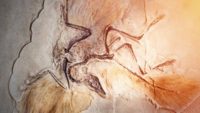Do these skulls prove common ancestry between apes and humans? Read More
Fruit flies’ ability to sniff out explosives explodes evolution myth Read More
The inclination of some evolutionists to project God-like powers onto nature is becoming more prominent in scientific literature. Some proudly personify nature in first-person, calling her Gaia after the Greek Earth goddess.1 Publishing in Science, evolutionary ecologist Tim Lenton from the University of Exeter and co-author, French sociologist Bruno Latour, laud nature’s innate cognitive pow… More… …read more Source: icr.org
By Harry F. Sanders, III Killifish have only rarely been addressed in major creationist literature and deserve a deeper look as they strongly point to a designer. …read more Source: AIG Daily
The biblical model of origins maintains the first forms of life created by God were the land plants complete with root systems on Day 3 of creation week. The first life did not evolve from inorganic non-life in some unknown primal ocean some unknown time ago. Land plants were fully-formed and functional—leaves, stems, flowers, seeds, roots, etc.—“In the beginning.” Not surprisingly, a recent ar… More… …read more Source: icr.org
By Matthew Augusta Even though some intestinal bacteria strains are pathogenic and deadly, most coliforms strains still show evidence of being one of God’s “very good” creations. …read more Source: AIG Daily
By Tom Hennigan Your irresistible urge to snatch up that cute little puppy and hug it for all you’re worth isn’t just a feeling. It’s science. …read more Source: AIG Daily
By Ken Ham A recent CBC news story caught my eye (that may be because the monkey in the article’s first picture is not going for the bananas, or that I was thinking I would make sure to thoroughly wash any of those fruits the monkey was walking over before eating). But it seems that researchers studying plants in Uganda and Madagascar have found that plants seem to produce fruits in colors matching what the local animals that eat them can easily see. There are various types of plants which are similar in both countries, even though they are over [More]
By Harry F. Sanders, III Fossils are often found where they are not expected, and these finds cause evolutionists to frequently revise their timelines. …read more Source: AIG Daily
Unusually deep evaporite deposits underneath the Mediterranean have some scientists scratching their heads-but there is a biblical answer to the mystery. …read more Source: creation.com
A major unanswered question for evolution is: why are humans the only species that can talk? Secular researchers have tried to find an answer since Darwin’s day, but so far they have not found satisfactory answers. One theory is that only humans possess the anatomy that allows speech.1 But the fact is that “humans and other primates have very similar vocal anatomy”—the physical machinery t… More… …read more Source: icr.org
God’s amazing creation is full of never-ending surprises. Read More
Secular scientists recently determined that most of the dinosaur fossils in the Morrison Formation were buried quicker than commonly thought.1 The Morrison Formation is famous for its compositional consistency and massive extent across the American West, covering nearly 700,000 square miles, and for its rich dinosaur quarries. The Morrison Formation is remarkable for its dinosaur fossils an… More… …read more Source: icr.org
1.8 billion years have allegedly gone by but these rapidly-reproducing bacteria haven’t changed in all that supposed time Read More
A new development in mathematical modeling from Dr. Robyn P. Araujo at Queensland University of Technology in Brisbane, Australia, goes a long way to help explain how creatures adapt.1 A design-based interpretation of her findings causes the math models to be integral to understanding the engineered mechanisms that enable organisms to rapidly solve environmental challenges. Dr. Araujo, a lecturer in applied… More… …read more Source: icr.org
Many people know that Strychnos plants contain strychnine, a deadly poison. The discovery of its flowers in amber is ‘deadly’ to evolution. …read more Source:
By Dr. Danny R. Faulkner Creationists frequently quote Hubble to the effect that he inserted the cosmological principle to avoid stark realties about the universe that his data implied. …read more Source: AIG Daily
The beautiful glossy rainbow weevil from the Philippines is unique for the spectacular rainbow colored spots on its thorax and forewing. These circular spots produce all the colors, and in the same order, as those found in a rainbow in a series of successive rings. Many insects exhibit the ability to produce different types of colors, but it’s unusual for one to exhibit such a vast spectrum. Researchers are deep… More… …read more Source: icr.org
By Dr. Ron Samec After 29 years of research, a creation astronomer has observable evidence that stars can’t be billions of years old. …read more Source: AIG Daily
By Simon Turpin The BBC’s evolution quiz involved seven questions that had to be answered true or false. So, let’s take the quiz and test the BBC’s understanding of evolution. …read more Source: AIG Daily
By George F. Howe The palo verde tree is well known to residents of the desert southwest and Mexico, yet there are few studies of it in the technical literature. …read more Source: AIG Daily
By Ken Ham A recent study, led by the Spanish National Cancer Research Centre, found around 20% of the genes which had been classified as coding genes were not coding. …read more Source: AIG Daily
By Karin Viet Neo-Darwinism offers this basic equation for evolution: mutations + natural selection + millions of years = particles-to-person evolution. …read more Source: AIG Daily
By Dr. Andrew A. Snelling Forming the coveted qualities of jade requires unique conditions unlike anything on earth today. …read more Source: AIG Daily
By Ken Ham A recent find at two archaeological sites in Croatia (just across the Adriatic Sea from Italy) discovered dairy lipids in several fragments of jars of pottery. This means these people were likely producing cheese and storing it for eating later. In most cases, pottery fragments finds are carefully washed. But the researchers decided to keep some pots unwashed so as to be able to do an analysis and see if they could determine what was in the jars. Had all of the pottery been washed, any traces of dairy would have been lost. So this is an [More]
By Ken Ham A news item caught our eye this week. It was reporting on a study which found that the bonnethead shark (a smaller relative of Hammerhead sharks) actually eats and digests seagrass. Now, scientists have noticed these sharks eating seagrass for several years but, perhaps influenced by their evolutionary worldview, had assumed they were just eating the seagrass to get at crabs, shrimp, or small fish living in and around the seagrass. But when researchers fed some captive bonnethead sharks a mostly seagrass diet, they noticed that the sharks did just fine. The researchers used Carbon-13 to label [More]
By Dr. Matthew E. Ingle How could large reef systems with many generations of coral have grown in the approximately 4,400 years since Noah’s Flood? …read more Source: AIG Daily











































